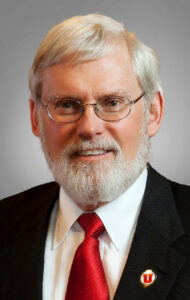
After more than two decades away from the college as a senior administrator, Dr. David W. Pershing, who finished his tenure last month as the University of Utah’s 15th president, returned to the storied halls of the Merrill Engineering Building to rejoin the College of Engineering as a professor.
“It’s wonderful to be back in the college!” said Pershing, who is a Distinguished Professor and received the Distinguished Research and Rosenblatt Prize for Excellence during his time in the U’s Department of Chemical Engineering.
Pershing said he is back part-time — half of his week will be spent in Merrill Engineering where he will eventually return to teaching in the Department of Chemical Engineering. The other half is covered by administrative leave earned years ago while dean of the College of Engineering. He will also continue working with the University’s Institute for Clean and Secure Energy, an interdisciplinary research center under the leadership of chemical engineering professor Phil Smith. In addition to his work within the College of Engineering, Pershing will assist with some central administration transitions.
“The College faculty, students and staff are proud that Prof. Pershing served as provost and president,” said College of Engineering Dean Richard B. Brown. “He certainly left his mark on the campus as a whole. We are delighted to have him back in Engineering!”
Pershing joined the University of Utah as a professor of chemical engineering in 1977 where his research focused on coal combustion. He was named Distinguished Professor in 1995 and was dean of the College of Engineering from 1987 to 1998. In 1998, he became senior vice president for Academic Affairs and then university president in 2012.
“I loved working with students. As president, you get to do that, and it’s one of the things I’m looking forward to about being back in the College again,” he said, looking back at his six-year tenure as president. “I also love the fact that we were able to make some real progress in a number of areas, focusing particularly on undergraduate education. We drove up retention rates and graduation rates. We were able to rebuild the campus during the periods I was senior vice president and president.”
During that time, scholarships at the U nearly doubled, and the retention rate nearly reached 90 percent for first- to second-year students. Also, more than 30 buildings and structures were built on campus, including the Warnock Engineering Building, the Lassonde Studios, and the under-construction Carolyn and Kem Gardner Building, which is set to open later this year.
Pershing said he will begin teaching again in the fall of 2019, and he hopes to resume teaching chemical engineering classes focused on heat transfer.
“One of the exciting things is being back with students and the prospect of teaching again,” he said, sitting in his new office in the Merrill Engineering Building. “It’s been 25 years since I’ve been in this building. It doesn’t feel strange to be back here, but it will take a while to get used to it again.”